The History of Hooks
Introduction
 The hook had its origins in the Gorge, a device used by many primitive cultures, which is frequently found in prehistoric sites. The Gorge is a bi-pointed bone about four inches long, often with a hafting groove in the center. Gorges were made from slivers of bone, flint or turtle-shell which were attached to a line which was knotted through a hole in the centre of the Gorge. Gorge hooks may represent a stage between leisters or bone point tipped spears on the one hand and modern style hook and line fishhooks on the other. The hook had its origins in the Gorge, a device used by many primitive cultures, which is frequently found in prehistoric sites. The Gorge is a bi-pointed bone about four inches long, often with a hafting groove in the center. Gorges were made from slivers of bone, flint or turtle-shell which were attached to a line which was knotted through a hole in the centre of the Gorge. Gorge hooks may represent a stage between leisters or bone point tipped spears on the one hand and modern style hook and line fishhooks on the other.
The fish swallowed the Gorge end first in a bait, and the pull of the line levered the Gorge across the fish's throat, trapping it in place. There are many drawbacks to fishing with a Gorge. It is hard to conceal, difficult to bait, hard to hook large fish on, and liable to lose its hold while the fish is being played.
Despite these problems, in expert hands the Gorge can prove highly effective and it is still used in some places today. We do not know for certain when the hook was discovered, although we do know that Neolithic man used hooks, making them out of bone, shell, or thorn depending on which materials were to hand.
Pre-Historic Hooks
Mankind's superior status in nature can be ascribed to our ability to develop and use tools and technology in our struggle to survive. As far back as we know in history, people have caught fish for sustenance. Innumerable methods have been developed in order to catch the various fish species living under quite different conditions, from arctic to tropical waters. Many of the fishing methods and types of tackle that have been developed over thousands of years are still in use, both for sport, sustenance and commercial fishing.
The first known types of fish hooks were made of different materials. A problem for archaeologists, trying to establish the historical facts about fish hooks, is that the materials used were not very durable. There is reason to believe that the very first types of fish hooks were made of wood.
If you take a branch with twigs that stick out at suitable angles, it will take very little to make it into a reasonably good hook, and who could, for instance, wish for a sharper point than the pointed thorns of a hawthorn bush. A hook made from this material can be just as sharp as a modern hook. In the British Isles, fishermen from Wales to the Thames have caught flounders with hawthorn hooks right up to our time. Other hook materials that we know of are shells, bone and horn. Among other things, Native Americans used the claw of a hawk and the beak of an eagle to make hooks.
 To the left, is a picture of an Indian god fishing off the coast of Peru. The picture of the boat of rushes, with its terrifying dragon's head, is a ceramic decoration from the Mohica period which depicts the highest deity in combat with the demons of the sea. (v. Hagen, The Desert Kingdoms of Peru, London, 1965). To the left, is a picture of an Indian god fishing off the coast of Peru. The picture of the boat of rushes, with its terrifying dragon's head, is a ceramic decoration from the Mohica period which depicts the highest deity in combat with the demons of the sea. (v. Hagen, The Desert Kingdoms of Peru, London, 1965).
Many people assume that the use of wooden hooks must have been more or less impractical. Since wood floats, the hook would probably have to be
fastened to a stone or something else that was heavy enough to make it sink. It would be a rash assertion to maintain that fish will not take a floating hook. The fact is that fishermen have often regarded floating hooks as an advantage. Up until the end of the nineteenth century, and perhaps even later, Lapp fishermen used wooden hooks in the great cod fisheries in Lofoten in northern Norway. They carved their hooks of juniper, a tough variety of wood, and burned the point to make it hard. As late as the 1960's, Swedish fishermen preferred hooks made of juniper for burbot fishing. They claimed that the smell of juniper actually attracts the fish and also that the burbot has a tendency to spit out ordinary steel hooks. Juniper hooks with three sharp points, on the other hand, are impossible to dislodge.
The Stone Age man had implements good enough to make extra fine hooks from bone. The fact that no one knows when bone hooks came into use, is
largely due to the fact that bone as a material seldom defies the ages. Only under exceptionally favourable conditions, with extra calcareous soil, can bone be preserved for thousands of years.
8000 B.C.
The oldest known hooks seem to be the ones that have turned up in Czechoslovakia during the excavation of the skeletal finds from late Paleolithic
times. Ancient hooks have also been found in Egypt and Palestine. The oldest, found in Palestine, is believed to be 9,000 years old.
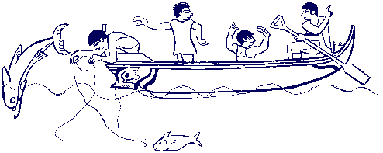 To the right, Etruscan fishermen on the sea, detail from Tomba della Caccia e Pesca in Tarquinia, assumed to have been painted around 510 BC. (Reproduced from a drawing in a FAO disertation by R. Kreuzer, Fish and its Place in Culture, 1973). To the right, Etruscan fishermen on the sea, detail from Tomba della Caccia e Pesca in Tarquinia, assumed to have been painted around 510 BC. (Reproduced from a drawing in a FAO disertation by R. Kreuzer, Fish and its Place in Culture, 1973).
In Norway, the oldest known fish hooks were dug up in "Vistehulene", some caves situated at Jæren, not far from Stavanger in the southwestern
part of Norway. These hooks are believed to be 7-8,000 years old. Finds of bone material on a ledge called Skipshelleren near Bergen are rather more recent. This is the richest discovery of bones that has been made in Norway, and among the wealth of implements here -- tools and equipment for hunting and fishing -- fish hooks have been found that show painstaking workmanship.
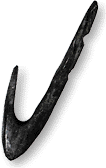 |
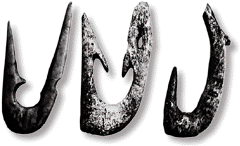 |
| Forty-three hooks and the remains of hooks have been found in the Vistehulene caves at Jæren in southwestern Norway. The oldest are possibly 7,000 years old. |
Three types of hooks from the rich find at Skipshelleren, situated close to the city of Bergen in western. |
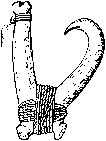 From Easter Island, probably made from human bone. A somewhat more morbid example of a material used for fish hooks, can be been found on Easter Island. As there were no large mammals on this island, there was a shortage of bone, and the custom was adopted of making hooks of human bone. Since human sacrifices were made on Easter Island until the first missionaries arrived at the turn of the last century, they had an abundant supply of human bone. From Easter Island, probably made from human bone. A somewhat more morbid example of a material used for fish hooks, can be been found on Easter Island. As there were no large mammals on this island, there was a shortage of bone, and the custom was adopted of making hooks of human bone. Since human sacrifices were made on Easter Island until the first missionaries arrived at the turn of the last century, they had an abundant supply of human bone.
In addition to hooks made out of one piece of wood, stone or bone, the Stone-Age Man often made compound hooks, with components -- often of different materials -- tied together. Compound hooks were stronger than the other types. While it is easy to break a slender, rounded bone hook, it would take a lot to break a securely tied compound hook.
As a general rule it appears that the most ancient hooks were made without barbs or any other refinement. The oldest hooks that have been found in
Denmark and Norway indicate that only after thousands of years were they equipped with barbs, grooves, bulges or holes to facilitate attachment of the bait and line.
 |
 |
| A type of hook used by fishermen in Småland, Sweden, and the method they used for fixing the 'hook'. Only one of the three points sticks out from the bait fish, and serves as a barb when the bait is swallowed. (Illustration from the Norwegian magazine "Fiskesport", 1957). |
 |
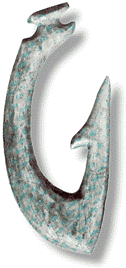 |
| A bone hook from Maglemose, Denmark, c. 6,200 BC. |
No one will dispute the beauty of this hook. It was found at Jortveit in Eide, Aust-Agder County, Norway, and is considered to be 4,000 years old. |
 |
 |
| A Japanese hook of reindeer horn. |
A compound hook from Volosova, Russia. |
2000 B.C.
By 2000 B.C., the Egyptians were fishing with rods, lines and hooks, a level of sophistication that the Chinese would not match for a thousand years, and which other civilisations, including our own, would wait even longer to attain. The early Egyptian hooks were made of copper, and were of simple shape. There was no barb, and the head was made by doubling the end of the shank over, which leaves open the possibility that these hooks may have had an eye. The length of these hooks varied from 2 to 6 cm, and the gape was wide in proportion to the length of the shank.
By the XII dynasty, barbed hooks were beginning to appear, and by the XVIII dynasty, bronze barbed hooks predominated. These later hooks had the end of the shank flattened to form a wider flange, allowing the line to be attached to the shank below the flange. By Roman times, iron and bronze hooks were in use, bronze of this period being made of a harder alloy than it is today.
15th Century
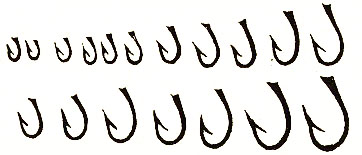 Sometime toward the end of the Middle Ages hook making is assumed to have become a specialized craft, and during the fifteenth century a description of making hooks (from needles) appears in The Boke of St. Albans, possibly written by Dame Juliana Berners. Sometime toward the end of the Middle Ages hook making is assumed to have become a specialized craft, and during the fifteenth century a description of making hooks (from needles) appears in The Boke of St. Albans, possibly written by Dame Juliana Berners.
Dame Juliana Berners published A Treatyse of Fysshynge with an Angle. In it, she described twelve styles of fly, with complete instructions on tying them. A century and a half later, Izaak Walton was still using the exact same patterns. Modern fishermen who have used them claim they are just as effective now as they were half a millennium ago. She was also one of the first conservationists. She hid her treatise in the great Boke of St. Albans, to discourage the interest of idlers in the sport of fishing, which they might destroy utterly by virtue of the skill acquired from this treatise.
Most helpfully, the Treatyse includes a wood cut of the hooks. Although the cut gives us a general idea of the shape of fifteenth century hooks, the limitations of printing methods of the era mean that reliance shouldn't be placed heavily on the size or gauge of the metal used.
17th Century
By the early seventeenth century, hooks were commercially available, but many anglers still chose to make their own. The reason for this was that commercially produced hooks were unreliable, chiefly because of uncertain temper. There was a prime opportunity for a quality hook maker to set up shop, and one duly did, the incomparable Charles Kirby.
Kirby hooks were of such good quality that the firm dominated the market during the late seventeenth and early eighteenth century, only losing its advantage when the crucible process for making steel became widely known. Kirby's great advantage was that he knew how to temper steel reliably, a secret which is said to have been passed to him by none other than Prince Rupert, Charles the First's nephew, military commander and inventor extraordinaire.
18th Century
The problem that the hook makimg industry faced was a simple technological one. The exact composition of the iron produced by early processes was difficult to control, and many of the early irons were brittle because they contained too much carbon. With the invention of the blast furnace, which appeared in Europe during the fifteenth century, it became possible to make iron on a large scale. By the middle of the sixteenth century, demand was such, and blast furnaces so common, that there was a scarcity of wood for producing charcoal.
The shortage became extremely pressing, but it wasn't until the early eighteenth century that it was discovered that coke could be used instead of charcoal. The use of iron only declined when it became possible to generate enough heat in commercial furnaces to produce steel during the mid-nineteenth century. In the interim period, steel was made on a small scale, using the crucible process, discovered in 1740. All high-quality steel was made by the crucible process until the electric furnace replaced it in the twentieth century.
Once high quality steel could be made reliably, needle and hook making became a much easier affair, and a large industry sprang up, with rival centres in Kendal, Redditch and Limerick. Kirby had lost his advantage, although the name still had considerable cachet. Hutchinson, a needle maker, started making hooks in Kendal as early as 1745, being joined by Adlington during the mid-nineteenth century. By 1823, Redditch had seventeen firms of hook makers established and the Limerick hook industry had been in existence for nearly thirty years.
19th Century
It was in Britain that hook making first developed as part of the industrial revolution. Hook making was spread out geographically in places such as Dublin and Limerick, Ireland; Aberdeen, Scotland; and Carlisle, England - names associated with hook shapes today. The town of Redditch, near Birmingham, was located in an inland district which became a center for fine steel and wire. This area evolved as a major producer of needles and by the mid-1800s a number of hook makers had appeared. It was from this district, and specifically from Redditch, that many other names, familiar to this day, were associated with bookmaking. Names like Bartleet, Alcock, Sealey, and Milward. Also from England, we have inherited names from Mr. Kirby and Mr. Sproat, both early hook designers.
By the late nineteenth century, hook making was a routine production process. The quality of hooks remained very variable. Hook-making was still in part a cottage industry, with batches of needles being farmed out to families for bending. One major source of complaint was the deep cut which many hook makers used to turn up a barb. Anglers of the day became resigned to the possibility of hooks breaking off at the barb.
Batch tempering wasn't a totally reliable process and fishermen became proficient at recognising soft hooks, which were light-blue instead of purple blue. Japanned hooks were a different matter, and the only way of detecting a faulty one was to test it by sticking the point in a cork and putting strain on the shank.
Shortly following the British advances in hook making, the Norwegian hook industry had its start when Sheriff Ole Mustad, and his son Hans, began hook production. From these beginnings in 1876, O. Mustad & Son has grown to become the worlds largest hook producer.
Eyed Hooks
Until the late nineteenth century, the vast majority of hooks were "blind" (i.e. they lacked an eye.) Incredibly, blind hooks were still being manufactured in the 1930s. It is a curious fact that the first illustration of an eyed hook was in 1660, in Les Ruses Innocentes, by Fortin. The first English illustration of an eyed hook was in Hawker's 1760 edition of The Complete Angler, which has a plate showing a fly dressed on an eyed hook. It took one hundred and fifty years for the new invention to catch on, despite the many problems that hooks tied to gut or horsehair presented. The classical method of attaching a fly to gut was, of course, to whip the fly onto the gut. Gut was liable to wear just in front of the end of the hook, rendering the fly useless. After even short periods of storage, gut had a strong tendency to shrink or rot, resulting in the loss of the fly.
Both gut and horsehair shared a common problem in that flies tied to them were hard to store, on account of the "spare" loop of line left to allow the fly to be attached to the cast. The eyed hook should have recommended itself, but for some reason it was ignored, tying to straight lengths of gut giving way instead to tying to a gut loop. The gut loop became popular in the first quarter of the eighteenth century, mostly for large flies. Smaller sizes of hook were still "tied to gut" in the traditional way. It is extraordinary how much suspicion was levelled at the eyed hook, which was denounced by O'Gorman in 1845 as "another Scotch invention". Even the great Kelson distrusted the eyed hook, and all his patterns were tied with gut loops.
There were various attempts to market eyed hooks during the mid-nineteenth century, including Hewett-Wheatley, and Warners and Son, both of whose ventures fell by the wayside. It wasn't until H.S. Hall's eyed trout hook came on the market in 1879 that there was any enthusiasm for a change, and that was fired by the rise in popularity of dry fly fishing, the salmon anglers being quite happy with gut loops. By the end of the century, up and down-eyed hooks were available in both salmon and trout sizes. A third variety of hook, sometimes called "needle-eyed" was also available, with a hole drilled perpendicularly through the end of the hook shank, but the design was flawed and failed to attract a following.
Hook Sizes
The large-scale manufacture of hooks in the early nineteenth century brought a new problem for the fisherman; one of comparing different firm's hook sizes. The confusion started in the nineteenth century, when a number of competing scales sprung up. There were various Redditch scales in use, Stoddart quotes one that ran from 1 to 16, with 16 the smallest. 1-7 were salmon sizes, 8-16 were trout sizes. The unified Redditch "old" scale ran from 1 to 19, with 1 the smallest trout size, and 19 the largest salmon size. Many round bend hooks were sized on a scale that ran from 00 (midge) to 20 (the largest salmon). At one time there were at least five different hook scale systems in operation, those being Carlisle, Kendal, O'Shaughnessy Limerick, Dublin (or Philips) Limerick, and Sell of Dublin. The confusion can only be imagined ! The growing popularity of eyed hooks in the late nineteenth and early twentieth century only made matters worse.
If the problem of deriving a common reference scale for hook sizes taxed many good minds in the past; it continues to do so. Various methods of hook measurement can be used, such as the overall length, the length of the straight part of the shank and width of the gap to name but three. All have their problems, which relate to the different proportions each manufacturer gives to their series of hooks. The ratio between width of gap and length of shank varies widely between different lines. Overall length is the easiest to measure, but the different dimensions of the bend of a Limerick and say a Sneck bend would result in
two hooks with very different lengths of shank being classified as the same size. Then again, many blind hooks were made intentionally long in the shank so that they could be cut to size by the tier. When eyed hooks appeared on the market, the diameter of eyes had to be taken into account, as eye size could make a major difference to the length of a small hook. There were a few brave attempts to produce standard hook scales, notably by Cholmondely-Pennel in the late 1880's, and by Pryce-Tannatt in 1914. Pennel's scale (running from the smallest, 000 to the largest, 19) was available until at least the beginning of the Second World War, but Pryce-Tannatt's did not last.
Modern systems concentrate on standardising the length of the shank, but this is a difficult measurement to make of a hog-backed hook, and differences in bend and eye diameter may conspire to make a small hook appear larger than its official size. No system can take account of hooks which are classified differently by custom, for example long shank trout hooks, which take their size from the gape of the hook, rather than the length of the shank. Consider the unofficial extension of the current system of measurement to account for sizes below size 16, and we are only marginally in advance of the chaos of the nineteenth century. As long as different makers continue to produce different patterns of hook, we are unlikely to see any improvement or for that matter, standardisation.
| Hook scales |
Sizes (small to large) |
| Carlisle |
12 or small midge,11 or middle midge,10 or large midge,9 or small fly,8 or middle fly,7 or large fly,6 or small cod-bait,5 or middle cod-bait,4 or large cod-bait,3 or small worm,2 or middle worm,1 or large worm, small grilse, middle grilse, large grilse, small salmon, middle salmon, large salmon |
| Redditch "new" |
18,17,16,15,14,13,12,11,10,9,8,7,6,5,4,3,2,1,0,2/0,3/0,4/0,5/0,6/0,7/0, 8/0, 9/0, 10/0 |
| Redditch "old" |
13,12,11,10,9,8,7,6,5,4,3,2,1 |
| Redditch (1830) |
12,11,10,9,8,7,6,5,4,3,2,1,0,00 |
| Adlington† |
00,0,1,2,3,4,5,6,7,8,9,10,11,12,13,14,15,16,17,18,19,20 |
| Kendal (1830) |
000,00,0,1,2,3,4,5,6,7,8,9,10,11,1213,14,15 |
| Pennell |
000,00,0,1,2,3,4,5,6,7,8,9,10,11,12,13,14,15,16,17,18,19 |
| H. S. Hall series |
000,00,0,1,2,3,4,5,6,7,8,9,10 |
| Sell |
(Trout) 8,7,6,5,4,3,2,1 (Grilse) 4,3,2,1 (Salmon) 6,5,4,3,2,1 |
| Philips |
midge, fe, f, ff, fff, C, CC, B, BB, 9, 8, 7, 6, 5, 4 |
| O'Shaughnessy |
(Trout) 9,8,7,6,5,4,3,2,1 (Grilse) 4,3,2,1 (Salmon) 6,5,4,3,2,1 |
| Limerick "rational" scale |
000,00,0,1,2,3,4, 4�, 5, 5�, 6, 7, 8, 9, 10, 11, 11�, 12, 13, 13�, 14, 14�, 15, 16, 17, 18, 18�, 19, 20, 21 |
Double & Treble Hooks
The double salmon hook can be thought of as a reasonably mature invention, given that during the bronze age, the Swiss used them extensively. As usual, English fishermen treated such an innovation with extreme caution, the first mention of a double salmon hook being made in literature in 1590. Venables discussed flies tied on double hooks for catching grilse and grayling, but the double hook didn't catch on overnight, and it was 1689 before one was illustrated and doubles didn't become truly popular until much later. Early double hooks were whipped together, but later versions were made by braising the metal. Cholmondely-Pennell designed and marketed a series of double hooks in the 1880's, by which time the idea was no longer regarded as dangerously novel.
Treble hooks share the chequered history of their cousins. They had little application in fishing until the twentieth century, mainly being used for live and dead baiting. By the late nineteenth century, trebles were also being used for spinning, and were a source of much complaint. Hooks frequently broke, the temper having been affected during the brazing procedure. The trouble was caused by the selection of wire that was of too fine a diameter, and which became extremely brittle during the manufacturing process. It would not be until after the Second World War that trebles came into widespread use for fly fishing, as it was only then that it became possible to manufacture hooks reliably in the small sizes required.
Irish Hooks
If Redditch had a serious rival, it was the Irish hook makers. The use of Irish products was de rigeur among salmon fishermen in the late eighteenth and early nineteenth centuries. The O'Shaughnessy family were the foremost firm of Limerick hook makers, establishing their business in 1795. They soon developed a formidable reputation for quality, their products costing sixpence a dozen and being recommended as a matter of course by eighteenth nineteenth century authors. The original O'Shaughnessy hooks were hammered out and forged, with the barbs filed out from the metal rather than being cut out and bent up as was the case with wire hooks. The founder died in about 1820 and by 1834, the business had been taken over by a watchmaker, who had carried on the tackle making business, turning out Limerick hooks after the original O'Shaughnessy pattern.
By 1845, a dozen hooks cost between four shillings and one shilling. The angler however, got a hook filed from best German steel, rather than the wire hooks which were the rule from Dublin and London firms. By comparison, Sell's hooks cost between three shillings and nine pence a dozen. O'Shaughnessy hooks were so prized that it was common practice to strip the fly from the hook after it had been mauled by fish. Not only did the hooks last for ever, they were simply too valuable to throw away ! The quality of the Limerick products stood head and shoulders above those of their competitors.
20th Century
Despite the growth of hook making elsewhere, England continued to dominate in the production of hooks. The finest craftsmen continued hook production into the twentieth century and until interrupted by World War II, their firms continued to satisfy the demands for quality hooks.
Today, only one major English producer of hooks continues, A. E. Partridge & Son, who absorbed the remains of some of it's notable predecessors. They still concentrate on specialized hooks for the fly tying industry, maintaining that tradition for which England is highly regarded. But, even this traditional British source is now under the control of O. Mustad & Son, since they purchased A. E. Partridge & Sons in 1996. Belvoirdale hooks are also produced in Redditch, but on a rather small scale.
It wasn't until the 1980s that Japanese hook producers made their presence felt in the world market for hooks. Tiemco led the way and was soon followed by a rash of other hook makers. These suppliers responded to demands specialised designs of high quality, and they soon gained acceptance within the industry.
 Fishing Tip : Fishing Tip : |
|
| Why not contact fishSA.com about your Fishing Tip |
|
|